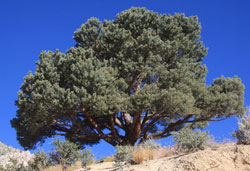Piñon decline was first observed in 1994 and has been sited in Durango, Salida and the urban Front Range from Denver north to Fort Collins. The first symptom of decline is a clear sap exuding from two- to three-inch-diameter branches. As the disease progresses, the needles turn brown and die within one season.
 The dying branches occur randomly throughout the tree and should be removed. The entire tree may not die, but over the course of several years branches will die and the tree will become more open. Piñon decline is most often found in trees that are at least 20 years old and that have grown very little over the last four to five years. Insects have not been found in dead and dying branches.
The dying branches occur randomly throughout the tree and should be removed. The entire tree may not die, but over the course of several years branches will die and the tree will become more open. Piñon decline is most often found in trees that are at least 20 years old and that have grown very little over the last four to five years. Insects have not been found in dead and dying branches.
Piñons require no additional moisture once they are established and excess water may exacerbate the decline. Less than 10 inches precipitation per year is recommended. Although not known to cause piñon decline, the stress caused by excess soil moisture may make the tree more susceptible.
For more information, see the following Colorado State University Extension fact sheet(s).
For more information, see the following Planttalk Colorado™ script(s).



